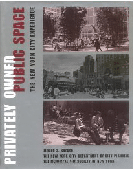
167 East 61st Street
By design, this residential plaza declines to distinguish between public and private users. Located on the north side of East 61st Street slightly west of Third Avenue, the deep, rectangular space leads at a slight incline to the lobby entrance. There is no physically separate entry corridor within or next to the space, under canopy or set off by obstructions, dedicated to residents, nor is there a front door located away from the public space. Members of the public and residents of the building share the space equally, even as they pursue distinct ends.

That is not to say that this condition of integration is uniformly applauded. One Trump Plaza resident in his forties tersely complains, “I live here, so I don’t like it. Anybody can come.” Revealing a more accommodating attitude, a younger resident comments, “I knew it was a public space. I read the offering plan, and there’s a little plaque that gives the details. I think it’s very attractive. . . . As long as people don’t litter, and they appreciate it and enjoy it without destroying it, that’s what it’s there for. I think it enhances the building. It also enhances the city.” The doorman succinctly sums up: “The public comes everyday. The residents use it.”
As with many public spaces on side streets, the pedestrian on the avenue cannot see it even though it is only steps away. One idea worthy of future consideration is to require owners of avenue frontage buildings with side street spaces to display a public space plaque on the avenue side with directions to the space. The Trump Plaza plaque is located at the southeast edge of the space, behind fast-growing landscaping that has in the past threatened to obscure the sign. In the late 1980s, there was a neighborhood epidemic of plaque thefts, and this one was literally ripped off the wall by thieves presumably interested in its brass content. More recent plaques have been fabricated from less valued materials.
Bordering the west side of the space is a tall, wide water wall composed of vertically mounted stone strips carved with horizontal ridges that momentarily grip the water as it makes its downward fall into the pool. The wall resembles a war memorial awaiting the inscription of names of fallen soldiers. A built-in polished granite bench stretches along the water wall and pool. The water element is sufficiently well-regulated that users may sit with the assurance that they will not be drenched by spray. The same cannot be said for the drinking fountain, with its occasionally startling spurts, but at least it works, a condition too often absent at other residential plazas.
On the eastern side of the space is another built-in granite bench nestled into a large planter filled with a variety of trees and bushes. Users play hide-and-seek with the sun. In late morning, sunlight pours over the western side; parents and caregivers with babies appear to prefer the shady side, while messengers and joggers clearly like the sun. At the rear of the plaza are two more benches.
West of the lobby, where there is a small, naturalistic, outdoor garden, issues of public versus private become more sensitive. The doorman matter-of-factly instructs that “the public space ends here; the garden isn’t public.” Since the garden is part of the residential plaza, he is technically wrong. Since the garden is classified as “visual residual space,” however, he is, for practical purposes, right. Unlike primary and usable residual subcategories of residential plazas, this subcategory may exclude physical public access, rendering it a “look, but don’t touch” geography. Additional visual residual space is located at the back of Trump Plaza on East 62nd Street.


